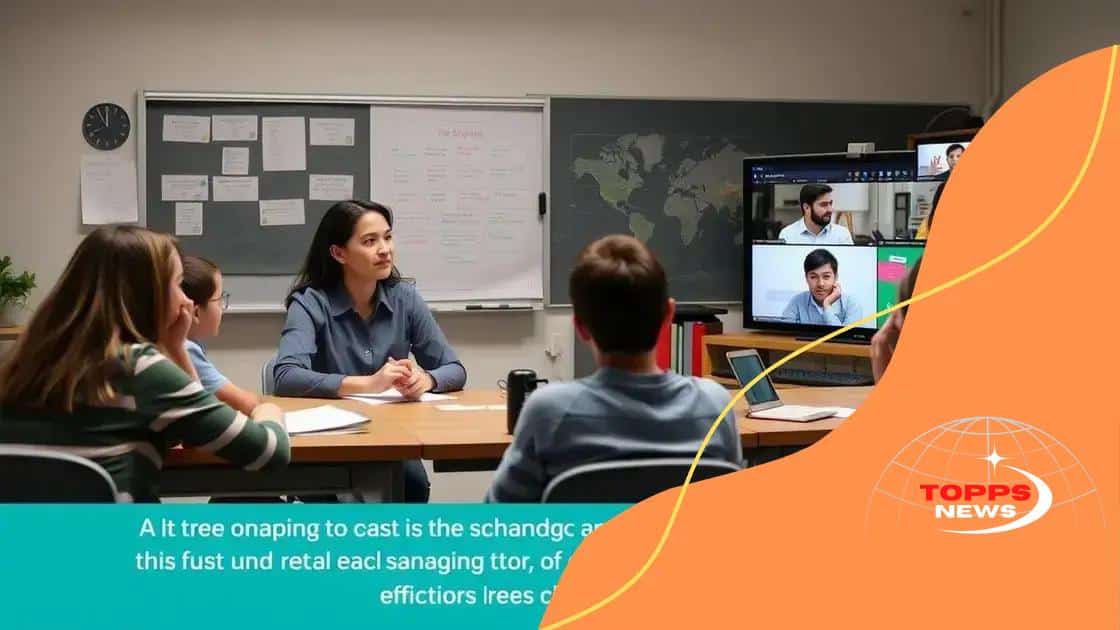Hybrid learning models’ effectiveness in modern education

Hybrid learning models’ effectiveness combines in-person and online education to enhance student engagement, flexibility, and personalized learning experiences while addressing challenges like technology access and teacher preparedness.
Hybrid learning models’ effectiveness has emerged as a vital topic in education today. With schools adapting to technology, it’s fascinating to see how these methods influence student engagement and learning outcomes.
Understanding hybrid learning models
Understanding hybrid learning models is essential in today’s educational landscape. With the rise of technology, educational institutions are blending traditional classroom methods with online learning. This blending creates a more flexible and engaging learning environment for students.
Key Components of Hybrid Learning
There are several key components that make up effective hybrid learning models. These include:
- Combination of in-person and online instruction
- Flexible scheduling for students
- Utilization of technology to enhance learning experiences
- Engagement strategies that cater to diverse learning styles
These components work together to help students stay motivated and involved in their educational journey. For example, in a typical hybrid classroom, students might attend in-person classes a few days a week while completing online work during the days they are not in class.
Benefits of Hybrid Learning
One of the significant benefits of hybrid learning models is personalization. Students can learn at their own pace, taking the time they need to understand the subject matter fully. Additionally, teachers can monitor progress more effectively and provide tailored support.
Moreover, technology plays a crucial role. With the use of online platforms, learning materials can be updated quickly, making information more current. Also, students often find digital materials more engaging than traditional textbooks.
Overall, understanding hybrid learning models offers insight into how education is evolving. As more institutions adopt this approach, it will be crucial to assess both its effectiveness and how it impacts student outcomes.
Benefits of hybrid learning approaches
The benefits of hybrid learning approaches are numerous and impactful. These methods combine the best of both worlds, offering traditional classroom experiences alongside the flexibility of online learning. By doing this, students may find themselves more engaged and motivated to learn.
Enhanced Flexibility
One of the primary advantages is the enhanced flexibility that hybrid learning provides. Students can manage their schedules better, allowing them to balance studies with personal commitments. For example, they might attend in-person classes a few times a week while completing assignments online during their free time.
- Access to materials anytime and anywhere
- Ability to learn at one’s own pace
- Opportunities to revisit recorded lectures
This flexibility often leads to better retention of information, as students can learn in their preferred environments, whether at home or in a classroom.
Increased Engagement
Incorporating technology into the classroom can significantly boost student engagement. The tools used in hybrid learning models can make learning more interactive. For instance, online quizzes and multimedia presentations can enrich the learning experience.
With online platforms, students can collaborate easily on projects and communicate through forums or chat features. Such interactions can encourage teamwork and foster a supportive learning community. Additionally, the blend of learning styles caters to diverse preferences, enhancing overall satisfaction.
Moreover, hybrid learning approaches empower educators to reach a wider range of students. Teachers can use varied instructional methods to address different learning needs, ensuring that all students can thrive.
Challenges faced in hybrid learning

Challenges faced in hybrid learning are significant and must be addressed for these models to be effective. While this approach is innovative, it also presents various obstacles that can affect both students and educators.
Technological Barriers
One major challenge is the reliance on technology. Not all students have access to the necessary devices or reliable internet connections. This lack of access can create disparities in learning opportunities, which is especially concerning for disadvantaged students.
- Inconsistent internet connectivity
- Limited access to laptops or tablets
- Difficulty in navigating online platforms
These technological barriers can lead to frustration and disengagement among students, making it vital to find solutions that ensure everyone can participate fully.
Teacher Training
Another challenge involves the training of educators. Many teachers may not be fully prepared to deliver instruction in a hybrid environment. This lack of training can result in ineffective teaching practices, diminishing the potential benefits of hybrid learning.
Teachers need guidance on how to integrate technology into their lessons effectively and how to keep students engaged both online and in-person. Providing professional development opportunities is crucial to equip educators with the skills they need to succeed.
Classroom Dynamics
The dynamics of the classroom can also be impacted. Managing a class with both in-person and remote learners can create difficulties, as teachers must cater to two different groups simultaneously. This can lead to challenges in maintaining engagement and ensuring that all students receive equal attention.
Moreover, students in hybrid settings may feel isolated from their peers, particularly those learning remotely. This sense of isolation can negatively affect their motivation and overall learning experience, highlighting the need for strategies that foster a sense of community.
Effective strategies for implementation
Implementing effective strategies in hybrid learning can significantly enhance the experience for both students and educators. To achieve success, schools and institutions need a well-structured plan that focuses on engagement and accessibility.
Clear Communication
One effective strategy is to establish clear communication channels. Students should know how to reach their teachers and peers, whether they are attending classes online or in person. Regular updates about assignments and important dates help keep everyone on the same page.
- Create a centralized platform for announcements
- Encourage regular feedback from students
- Use multiple communication methods (email, chat, video calls)
Having these communication tools readily available ensures that students feel connected and supported in their learning journey.
Flexible Learning Paths
Another key strategy involves offering flexible learning paths. Providing choices for students in how they learn can lead to greater engagement. For instance, allowing students to pick assignments that interest them or choose between online and face-to-face interactions can enhance their motivation and commitment.
Incorporating varied teaching materials also plays an essential role. Using videos, interactive simulations, and group projects can cater to different learning styles. This variety can make the content more interesting and accessible for everyone.
Regular Training for Educators
Ongoing professional development for teachers is crucial. Training them on the latest technologies, teaching practices, and classroom management techniques ensures they are equipped to handle the demands of a hybrid learning environment. Encourage teachers to share their experiences and best practices with one another, fostering a collaborative culture within the institution.
Overall, these effective strategies can set a solid foundation for successful hybrid learning implementations. By focusing on communication, flexibility, and continuous training, schools can ensure that both students and educators thrive in this new learning landscape.
Future trends in hybrid learning
Future trends in hybrid learning are shaping the educational landscape in exciting ways. As technology advances, so do the methods and strategies used to deliver education. Anticipating these trends can help schools and students prepare for a more integrated learning experience.
Increased Use of Artificial Intelligence
One significant trend is the increased use of artificial intelligence (AI) in classrooms. AI can provide personalized learning experiences tailored to each student’s needs. For example, intelligent tutoring systems can assess a student’s knowledge and adapt lessons accordingly.
- Real-time feedback and assessment
- Customized learning paths for individual students
- Interactive virtual teaching assistants
With AI, students may receive more immediate support, helping them stay engaged and on track.
Greater Emphasis on Collaboration
Another trend involves a greater emphasis on collaboration in hybrid learning environments. Online tools now allow students to work together on projects, regardless of their physical location. This can increase student engagement and foster better teamwork skills.
Teachers can create collaborative assignments that require input from both in-person and remote learners. This interaction can help build a sense of community and connectedness among classmates, bridging the gap between different learning settings.
Focus on Mental Health and Wellbeing
As hybrid learning evolves, there is also a growing focus on mental health and wellbeing. Educators are becoming more aware of the challenges that students face in both online and in-person scenarios. Schools are prioritizing strategies that support the emotional and mental health of students.
Programs aimed at teaching coping skills and promoting mindfulness can help students navigate their educational journeys. Providing resources and support systems can ensure that students feel safe and valued in their learning environments.
Overall, staying informed about these future trends will help educators and students adapt to the changing landscape of education. By leveraging technology, promoting collaboration, and prioritizing mental health, the future of hybrid learning looks promising.
In conclusion, hybrid learning is transforming the way students engage with education. By combining traditional and digital methods, it offers flexibility and accessibility. As we move forward, focusing on effective strategies will be essential to maximize its benefits. Emphasizing technology, collaboration, and mental health support can create a more inclusive learning environment for all. With these aspects in mind, the future of education looks bright, promising a richer, more engaging experience for students everywhere.
FAQ – Frequently Asked Questions about Hybrid Learning
What are the key benefits of hybrid learning?
Hybrid learning offers flexibility, personalized experiences, and the opportunity to combine traditional and digital learning methods.
How does technology enhance hybrid learning?
Technology facilitates personalized learning paths, real-time feedback, and interactive tools that engage students effectively.
What challenges do schools face with hybrid learning?
Common challenges include technological barriers, training for educators, and managing classroom dynamics between in-person and online students.
What strategies can improve hybrid learning outcomes?
Implementing clear communication, ongoing teacher training, and prioritizing mental health support are effective strategies for enhancing hybrid learning.





